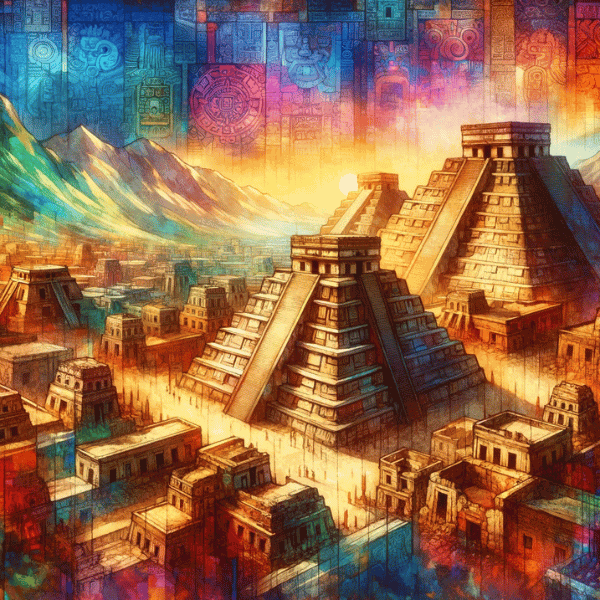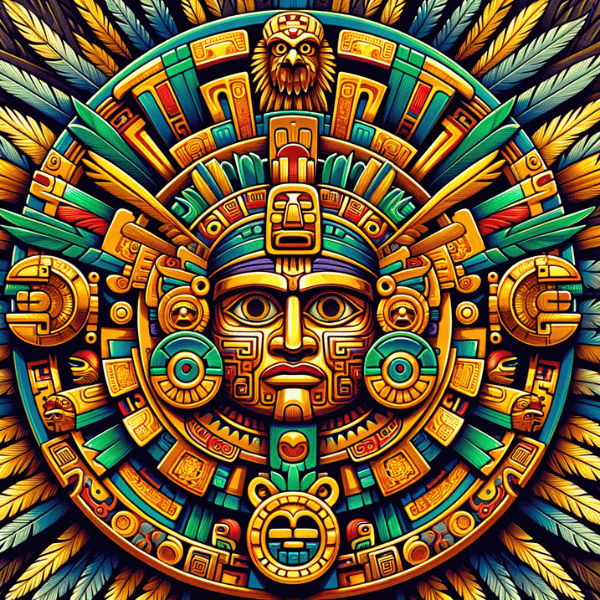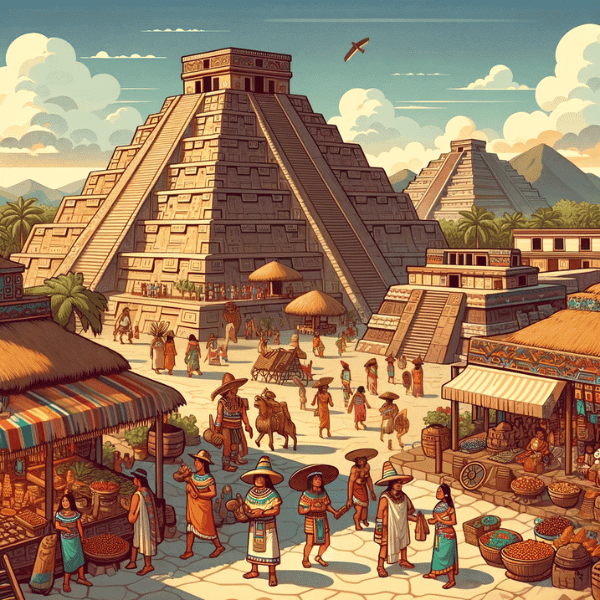Tonatiuh, revered as the Aztec Sun God, stands as a pivotal figure in Mesoamerican mythology, embodying the essence of light and life. Central to Aztec cosmology, Tonatiuh’s imagery and lore permeated their culture, profoundly influencing their daily lives, religious practices, and cosmic understanding. As the radiant deity driving the sun across the sky, he was not just a celestial symbol but a core part of the Aztec’s societal fabric. His worship, interwoven with rituals and sacrifices, underscored the Aztecs’ deep connection with the natural world and their belief in the cyclical nature of life and time. This article delves into the intriguing world of Tonatiuh, exploring his mythological roots, cultural significance, and enduring legacy in the rich tapestry of Aztec history.
| Attribute | Tonatiuh Information |
|---|---|
| Origin | Aztec Mythology |
| Deity Type | God of the Sun and Warfare |
| Role | God associated with the sun, war, and the heavens |
| Sun Disk | Often depicted as a sun disk with rays, symbolizing the sun’s radiance |
| Human Sacrifice | Honored with human sacrifices to ensure the sun’s journey across the sky |
| Cultural Impact | A central deity in Aztec religion, symbolizing the sun’s power and importance |
| Depictions | Featured in Aztec art and rituals, particularly those related to the sun and warfare |
1. Historical Context and Mythological Origins
Aztec Civilization
The Aztecs, a Mesoamerican people who flourished in central Mexico from the 14th to the 16th century, created a complex civilization known for its architectural, artistic, and cultural achievements. Their society was deeply intertwined with religious rituals and cosmology, where gods like Tonatiuh were central. The Aztec empire was at its zenith when the Spanish conquerors arrived, marking a period rich in cultural and religious practices that deeply venerated the Sun God.
Mythological Origins of Tonatiuh
Tonatiuh’s origins in Aztec mythology are both fascinating and complex. Described in various codices and historical texts, he was the fifth sun god, following four previous suns, each representing a different era of the world. According to the legend, Tonatiuh was a warrior god who required daily sacrifices to journey across the sky, symbolizing the perpetual struggle between night and day. This narrative, derived from primary sources like the Codex Borgia, reflects the Aztecs’ perception of the universe as an ongoing battle between cosmic forces.

Iconography and Symbolism
The depiction of Tonatiuh in Aztec art and architecture is rich with symbolism. Often portrayed with a fiery, golden disc surrounding his face, representing the sun, and with eagle feathers adorning his head, symbolizing his status as a warrior deity. His imagery frequently appears in the center of the Aztec solar calendar, emphasizing his importance. The use of specific colors, motifs, and symbols in these representations was not merely artistic but served as a form of visual language, conveying religious and cultural values central to the Aztec way of life.
2. The Role and Significance of Tonatiuh
The Sun God
As the sun god, Tonatiuh was central to the Aztec understanding of the cosmos. Each dawn, his emergence represented the victory of light over darkness, a daily reaffirmation of life itself. The Aztecs believed that Tonatiuh’s journey across the sky was an act of continual sacrifice and struggle, reflecting their view of the universe as a place of constant conflict and renewal. This journey was not just a celestial event but a narrative that shaped their worldview, emphasizing the importance of endurance and resilience.

Religious Practices
Worship of Tonatiuh was marked by elaborate rituals and ceremonies, deeply embedded in the Aztec’s religious practices. Primary sources, such as the Florentine Codex, detail these rituals, which often involved human sacrifices to provide Tonatiuh with the strength to battle the darkness. These sacrifices, seen as vital to the maintenance of the cosmic order, were conducted with great ceremony in temples dedicated to the sun god. These practices reflected the Aztecs’ belief in the interconnectedness of the divine and the mortal realms.
Influence on Aztec Society
The veneration of Tonatiuh had profound implications for Aztec society. His worship influenced various aspects, from daily activities to grand political decisions. The Aztec calendar, closely linked to the sun god, governed agricultural and ceremonial cycles, ensuring that society’s rhythm was in sync with the perceived needs of the cosmos. In warfare, victories were seen as offerings to Tonatiuh, reinforcing the belief that martial success was a divine mandate. Politically, rulers often aligned themselves with Tonatiuh, embodying his qualities of strength and leadership, further integrating religious belief with governance.
3. Comparative Mythology
Tonatiuh vs Other Sun Deities
Comparing Tonatiuh with sun deities from other mythologies reveals fascinating parallels and contrasts. For instance, in Egyptian mythology, Ra, the sun god, is also central to creation and daily life, much like Tonatiuh. Both are seen as life-giving forces, driving the sun across the sky. However, unlike Tonatiuh’s association with warfare and human sacrifice, Ra’s depiction often leans more towards a benevolent, life-giving force. In Greek mythology, Apollo, associated with the sun, embodies qualities of beauty, music, and arts, a contrast to Tonatiuh’s warrior aspect. These comparisons underscore the diverse ways different cultures envisioned and revered the sun.
Shared Themes and Divergences
A common theme in sun worship across various cultures is the sun as a symbol of life, power, and renewal. However, the interpretation of these themes varies significantly. In Aztec culture, the sun’s journey mirrors the struggles of life, necessitating sacrifices to ensure cosmic balance. In contrast, Norse mythology portrays the sun as Sol, a goddess chased by wolves, symbolizing the perpetual chase of night and day, but without the same emphasis on human sacrifice. These divergences highlight the unique cultural perspectives and values embedded in each mythology’s interpretation of the sun and its deity.

4. Tonatiuh in Modern Culture
Cultural Legacy
The legacy of Tonatiuh and Aztec mythology extends far into modern culture, influencing contemporary art, literature, and even popular media. Tonatiuh’s symbolism, often representing strength, renewal, and the natural cycle of life, has been a source of inspiration for various artists and writers. In literature, elements of Aztec mythology have been woven into narratives that explore themes of creation, destruction, and rebirth, reflecting the enduring relevance of these ancient stories. In modern art, the vibrant colors and powerful imagery associated with Tonatiuh continue to influence artistic expressions, often as a means to reconnect with or reinterpret indigenous heritage.

Reinterpretations and Representations
Contemporary depictions of Tonatiuh often blend historical accuracy with creative reinterpretation. In media such as film, television, and graphic novels, Tonatiuh is sometimes portrayed in a manner that resonates with modern audiences, balancing the traditional aspects of the deity with contemporary interpretations. This includes depicting him not just as a fierce warrior, but also as a symbol of resilience and hope. These modern representations often spark renewed interest in Aztec mythology, leading to a deeper understanding and appreciation of this rich cultural heritage.
5. Conclusion
Throughout this exploration, Tonatiuh emerges not just as a figure of ancient reverence but as a symbol whose influence transcends time, echoing in modern culture, art, and thought. From his mythological origins in the heart of Aztec civilization to his symbolic representation of strength, sacrifice, and renewal, Tonatiuh embodies a complex tapestry of cultural significance. His comparative analysis with other sun deities highlights the diverse global perceptions of the sun’s power. Modern reinterpretations further illustrate his lasting impact, bridging past and present, and continuing to inspire a deeper appreciation of Aztec heritage. Tonatiuh’s enduring legacy is a testament to the profound and lasting influence of ancient mythologies on human culture and understanding, resonating across centuries.
